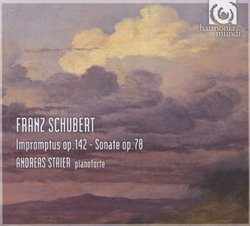It's the Hammers!
Giordano Bruno | Wherever I am, I am. | 08/12/2010
(5 out of 5 stars)
"The "Hammerklavier" of Haydn's and Beethoven's era was essentially a harpsichord with zither mallets instead of plectra, a 'hammer harpsichord' in basic shape and stringing. The hammers were wood covered with thin leather. The salient distinction was that the 'action' permitted the player to 'touch' the string with subtle degrees of force, thus achieving a smooth continuum of dynamics from loud to soft, exactly what was expressed in the English name for in the instrument, the "fortepiano." The harpsichord, by that time, had its own possibilities of dynamics based on registers and dampers, but those dynamics were 'stepped' rather than fluid over a spectrum. It was the dynamics acheived by the player's touch, far more than the timbre of the instrument, which distinguished the fortepiano from the harpsichord. The stepped dynamics of the harpsichord, by the way, were and are intrinsic to music composed for that instrument, Bach's Goldberg Variations for instance.
The instrument for which Franz Schubert composed the two sets of four movements recorded on this CD was an evolved, improved version of the fortepiano, and the instrument played here by Andreas Staier is a facsimile, built in 1996, of an original Viennese fortepiano built in 1827. This performance, to my ears, makes a very compelling case for the value of playing Schubert's sonatas on fortepiano as opposed to the modern grand piano. The modern instrument is grossly misnamed, of course; it should be a forte, since it is intentionally a very LOUD instrument, constructed to be suitable for vast concert halls. Is it possible that the Schubertian fortepiano had advantageous qualities that have been lost in later instruments? This performance suggests an affirmative. The question is primarily about the 'response' of the instrument to the 'touch' of the player, which comes down to the hammers. These two sonata-like sets of movements are perhaps the most 'hammer-esque' of Schubert's compositions, constructed "more on timbre than on thematic elements" (Walter Durr, in the liner notes). Sustained notes - melodic notes - are impossible on a fortepiano, and hardly less impossible on a modern piano except as prolonged decay. Instead, in Beethoven's piano works and even more plainly in these pieces by Schubert, sustained pitches are rendered by 'hammering' the same string in very rapid quavers and semi-quavers. A lot is demanded of the 'action' by the 'touch' in other words. It's the responsiveness of the lighter construction and harder mallets that make this performance brilliantly clear in phrasing. The lighter construction is paired with the lighter stringing, and absence of cross-stringing, that produces the harmonically cleaner and more transparent timbres of the fortepiano.
Andreas Staier is probably better known to most listeners as the harpsichordist of Musica Antiqua Köln, the 'prima' ensemble led by violinist Reinhard Goebel. He is forthrightly an exponent of 'historically informed performance', but he is more importantly a stupendous athlete on any keyboard, a player whose fingers can achieve any interpretation he wills. The interpretation here is a more vigorous, bolder, more heroic Schubert than you'll hear on any recital by modern pianists. And I think he "gets it right". Schubert plainly intended these two sets as bold experiments in sonata structure, as compositions going "beyond Beethoven" in exploring the musical resources of the Hammerklavier. Robert Schumann certainly recognized the originality of Schubert's work for solo klavier, but the question of Schubert's influence on later composers is murky since so much of his music was only published years after his death. If you've never heard these two compositions, I suspect you'll be surprised by their adventuresome qualities."

